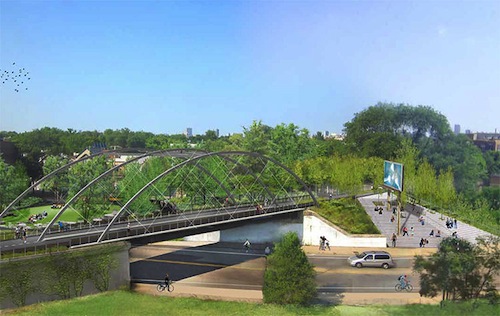Plans are moving forward to convert an unused, century-old Chicago rail artery to a 2.7 mile, 13-acre recreational facility and transit corridor. Unlike New York's High Line, the Bloomingdale Trail and Park will welcome bicycles as well as pedestrians, linking trendy and transitional neighborhoods on the city's Near North Side (Bucktown, Wicker Park, Logan Square, Humboldt Park) with public transportation to other parts of the city and suburbs.
Six "anchor parks" owned by the city will serve as access points to the trail, providing additional space for arts performances and recreation. Public funding will be used for the $91 million job, including $39 million in federal Congestion Mitigation and Air Quality funds. Michael Van Valkenburgh Associates led the Phase I planning team, with groundbreaking possible this year and completion as early as the end of 2014. Collins Engineers is helming the Phase II design, with Frances Whitehead named as lead artist. Participating agencies include the Chicago Department of Transportation, Chicago Park District, Department of Housing and Economic Development, Department of Cultural Affairs and Special Events, Trust for Public Land, and local community groups.
If the project succeeds, long-range plans would extend the trail eastward, ultimately crossing the Chicago River and Kennedy Expressway (I-90).
(http://www.archdaily.com/354677/chicago-on-track-to-break-ground-on-elevated-parkway/)
Related Stories
| Oct 5, 2011
GREENBUILD 2011: Brick offers growing options for sustainable building design
Brick exteriors, interiors and landscaping options can increase sustainability that also helps earn LEED certification.
| Oct 5, 2011
GREENBUILD 2011: Roof hatch designed for energy efficiency
The cover features a specially designed EPDM finger-type gasket that ensures a positive seal with the curb to reduce air permeability and ensure energy performance.
| Oct 4, 2011
GREENBUILD 2011
Click here for the latest news and products from Greenbuild 2011, Oct. 4-7, in Toronto.
| Oct 4, 2011
GREENBUILD 2011: Methods, impacts, and opportunities in the concrete building life cycle
Researchers at the Massachusetts Institute of Technology’s (MIT) Concrete Sustainability Hub conducted a life-cycle assessment (LCA) study to evaluate and improve the environmental impact and study how the “dual use” aspect of concrete.
| Oct 4, 2011
GREENBUILD 2011: Johnsonite features sustainable products
Products include rubber flooring tiles, treads, wall bases, and more.
| Oct 4, 2011
GREENBUILD 2011: Nearly seamless highly insulated glass curtain-wall system introduced
Low insulation value reflects value of entire curtain-wall system.
| Oct 4, 2011
GREENBUILD 2011: Ready-to-use wood primer unveiled
Maintains strong UV protection, clarity even with application of lighter, natural wood tones.
| Oct 4, 2011
GREENBUILD 2011: Two new recycled glass products announced
The two collections offer both larger and smaller particulates.
| Oct 4, 2011
GREENBUILD 2011: Mythic Paint launches two new paint products
A high performance paint, and a combination paint and primer now available.
















